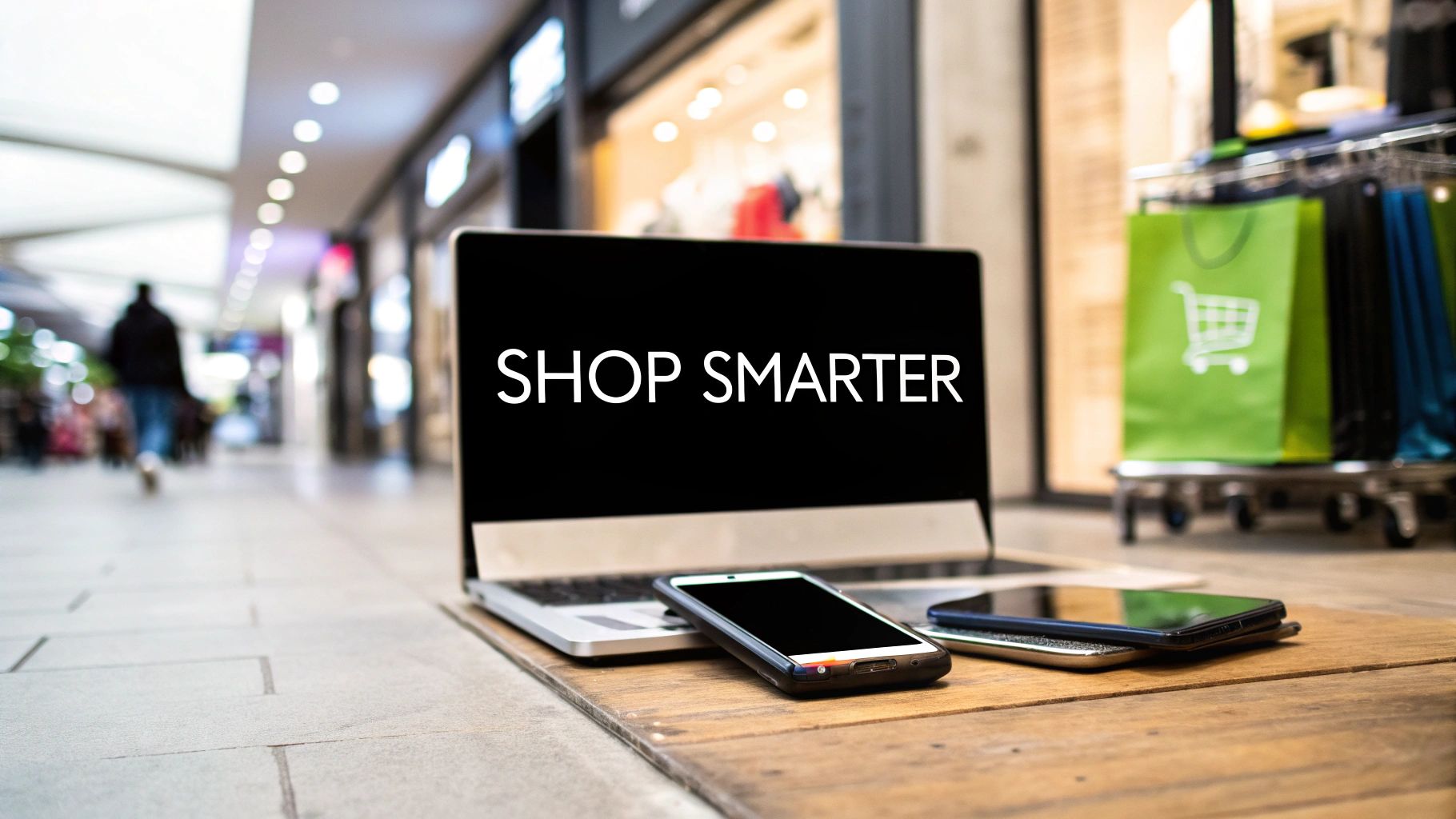
Navigating Today's Complex Shopping Landscape
Today's shopping environment presents a vast array of choices, both online and in physical stores. This abundance can make smart shopping feel overwhelming. However, informed shoppers are adapting by understanding key changes in consumer behavior. This understanding becomes a powerful tool for navigating the marketplace effectively.
The Rise of E-Commerce and Shifting Consumer Priorities
The continued expansion of e-commerce is a major shift in the shopping landscape. It's no longer just about convenience; it's transforming how we discover, compare, and buy everything from daily necessities to high-value items. The online grocery sector, for example, is experiencing significant growth, with a remarkable 17.2% year-over-year increase. Even traditionally in-person purchases, like cars, are seeing a rise in online activity, showing a 21.4% year-over-year growth in online automotive sales. This digital shift emphasizes the importance of navigating online marketplaces strategically. More detailed statistics can be found here: Online Shopping Statistics
The Impact of Retailer Strategies
Retailers are also evolving, adapting their strategies in response to changing consumer preferences, particularly in the post-pandemic world. They are making significant investments in logistics to satisfy the demand for faster delivery. In 2023, global shoppers showed a clear preference for speedier shipping, prompting retailers to offer same-day or next-day delivery. This focus on speed and convenience can be leveraged to your advantage when comparing retailers and making purchasing decisions. For tips on navigating websites effectively, you might find this helpful: How to master site navigation
Recognizing Beneficial vs. Exploitative Trends
It's important to remember that not all emerging retail trends benefit the consumer. Some are designed to encourage spending. Discerning the difference between genuine value and manipulative marketing tactics is critical. For instance, while personalized recommendations can be useful, they can also lead to unintended purchases. Similarly, limited-time offers can create a false sense of urgency, prompting purchases before thorough price comparisons and needs assessments. This highlights the importance of a strategic shopping approach that prioritizes your financial well-being.
Turning Your Mobile Device Into a Money-Saving Powerhouse
That smartphone you carry everywhere isn't just for staying connected; it's a powerful tool for smarter shopping. Savvy shoppers use their mobile devices throughout the entire purchasing journey, from initial research to final checkout. This article reveals how you can transform casual browsing into strategic buying, using your phone to unlock significant savings.
Mobile Apps: Your Pocket-Sized Shopping Assistants
Several apps are designed to help you shop smarter on your mobile device. These apps offer features like price tracking, coupon aggregation, and deal alerts, putting savings right at your fingertips. For example, some apps automatically monitor price histories and notify you when an item's price drops. Others scan for applicable coupons at checkout, eliminating manual searching.
- Price Comparison Apps: Compare prices across multiple retailers instantly.
- Cashback Apps: Earn money back on purchases you'd normally make.
- Coupon Apps: Access digital coupons and promo codes for various stores.
- Deal Alert Apps: Receive notifications for flash sales and limited-time offers.
This interconnectedness has changed consumer behavior, with mobile commerce representing a significant portion of online sales. In 2023, mobile commerce accounted for 60% of all e-commerce sales, totaling $2.2 trillion globally as shoppers prioritize convenience. This trend is even more pronounced among younger generations, with 68% of Gen Z and 42% of millennials discovering products through social media. Find more detailed statistics here: Global Ecommerce Statistics
To help you choose the right tools, let's look at a comparison of some popular options:
To help you choose the right tools, we've compiled a comparison of some popular options:
Essential Mobile Shopping Apps Comparison:
Comparison of popular mobile shopping apps and their key features to help readers choose the best tools for price comparison, cashback, and deal finding.
| App Name | Best For | Key Features | User Rating | Price |
|---|---|---|---|---|
| Rakuten | Cash Back & Rewards | Cash back at thousands of stores, in-store & online offers, double cash back opportunities | 4.5 Stars | Free |
| Honey | Couponing & Discounts | Automatic coupon application, price history tracking, deal alerts | 4.6 Stars | Free |
| Capital One Shopping | Price Comparison & Deal Finding | Price drop alerts, coupon codes, product comparisons across retailers | 4.4 Stars | Free |
| Ibotta | Grocery & Retail Cash Back | Cash back on groceries and everyday purchases, personalized offers, bonus opportunities | 4.3 Stars | Free |
This table highlights some popular mobile shopping apps, their strengths, and their user ratings. Remember to research and compare features to find the best fit for your shopping habits.
In-Store Price Checking and Reviews
Your mobile device empowers you to make informed decisions even while shopping in physical stores. Nearly 80% of global consumers use their smartphones to compare prices or read product reviews inside brick-and-mortar locations. This allows you to instantly verify if you're getting the best deal and avoid impulse buys based solely on in-store promotions.

Mobile Security: Protecting Yourself While Shopping
While using your phone for shopping offers numerous advantages, prioritizing security is crucial. Using strong passwords and enabling two-factor authentication are essential steps. Be cautious when using public Wi-Fi for online transactions, as this can increase your vulnerability to cyber threats.
Avoiding Mobile Shopping Traps
Retailers often employ tactics designed for mobile shoppers, such as limited-time offers and personalized push notifications. These strategies can trigger impulse purchases. Being aware of these tactics allows you to make more rational decisions based on your actual needs and budget. Establishing a mandatory waiting period before completing a purchase can significantly reduce impulse spending.
By combining mobile shopping tools with cautious spending habits, you can transform your phone into a true money-saving powerhouse, maximizing your purchasing power in today's retail landscape.
The Perfect Timing: When to Buy Absolutely Anything

Paying full price often feels unnecessary, especially when you understand the cyclical nature of retail. This section explores these predictable pricing cycles to help you shop smarter and save money. We'll uncover how to anticipate price drops and recognize truly good deals.
Understanding Retail Pricing Patterns
Retailers employ predictable pricing strategies based on seasonal demand, product releases, and planned promotions. For instance, winter clothing often sees significant price reductions in late winter and early spring. This is because retailers need to clear out existing inventory to make way for the next season's merchandise. Delaying purchases of seasonal items can lead to significant savings.
Product Release Cycles and Discounts
New product releases frequently trigger price drops on older models. This is especially noticeable with electronics and tech gadgets. When the latest iPhone enters the market, previous generations become more affordable. Understanding these product cycles helps you anticipate these price reductions. Planning purchases strategically can maximize your savings.
Decoding "Flash Sales" and "Limited-Time Offers"
"Flash sales" and "limited-time offers" create a sense of urgency, encouraging immediate purchases. However, these deals aren't always as amazing as they seem. Many times, these promotions are simply regular discounts presented as exclusive events. Developing patience and resisting impulsive buying during these "sales" is a valuable skill.
Building Your Personalized Purchasing Calendar
Creating a personalized purchasing calendar is a smart shopping strategy. This calendar allows you to anticipate potential price drops months in advance. By tracking items you want and noting typical sale periods, you can time your purchases strategically. For example, if you know back-to-school sales usually begin in August, avoid buying supplies at full price in June or July.
- Track Desired Items: Maintain a list of the items you plan to buy.
- Note Typical Sale Periods: Research the typical sale periods for these items.
- Set Purchase Reminders: Use a calendar to remind yourself when to shop for the best deals.
Identifying Genuinely Rare Discount Opportunities
While many sales are predictable, truly exceptional discounts do exist. These can occur during clearance events, store closings, or special holiday promotions. Learning to differentiate between routine markdowns and genuinely rare offers will maximize your savings.
By understanding retail pricing strategies and exercising patience, you can often avoid paying full price. A well-timed purchase can positively impact your budget and contribute to your overall savings goals.
Outsmarting Retail Psychology at Its Own Game

Retailers invest heavily in understanding consumer psychology. They use various tactics to influence your buying decisions. But by recognizing these tactics, you can become a smarter shopper and make more rational choices. This knowledge gives you control over your spending and helps you avoid manipulation.
Decoding the Psychology of Store Layouts and Product Placement
Stores use strategic layouts to encourage impulse buys. Essential items, like milk and bread, are often placed at the back of the store. This forces you to walk past tempting displays. End-cap displays and eye-level shelving showcase premium products. This subtly guides your attention. Recognizing these tactics is the first step to resisting them. Make a shopping list and stick to it. This will minimize unplanned purchases.
Recognizing Digital Dark Patterns
Online retailers use digital dark patterns. These are deceptive design choices that nudge you towards specific actions. Some examples include countdown timers to create a false sense of urgency. Confirmshaming tactics make you feel bad for declining offers. Sneaky subscriptions are difficult to cancel. Being aware of these tactics lets you make informed decisions without feeling pressured. Consider using browser extensions that block pop-ups and other distracting elements. This allows you to focus on essential product information. You might be interested in: How to master category navigation
Emotional Detachment From Sales Messaging
Retailers use phrases like "Limited-time offers" and "flash sales." These trigger emotional responses, creating a fear of missing out. This can lead to impulsive purchases you don't need and can't afford. One effective strategy is a purchase-consideration period. Before buying, take a break for a few hours. This lets you re-evaluate the purchase rationally and determine if the item truly aligns with your needs and budget.
Evaluating Value Over Price
Retailers often conflate price with value. A higher price doesn't necessarily indicate higher quality. Focus on the product's features, functionality, and long-term benefits instead of just the discounted price. Develop a value framework. Consider factors like durability, usability, and long-term cost of ownership. This helps you assess the true value and separate wants from needs.
Maintaining Discipline in High-Pressure Environments
Mindful shoppers maintain purchasing discipline. They set budgets, prioritize needs, and research alternatives before entering high-pressure retail environments. They understand their spending triggers and develop strategies to avoid them. Unsubscribe from promotional emails that tempt you with impulse buys. Bringing a shopping list helps you stay focused and avoid unnecessary purchases. This proactive approach fosters a sense of control and leads to smarter spending decisions. This also helps to prevent buyer's remorse, the feeling of regret after making a purchase.
Leveraging Shopping Technology Most People Overlook

Beyond simply comparing prices on various websites, a range of powerful tools can significantly enhance your shopping skills. These tools help you make well-informed decisions, leading to substantial savings. This section explores these often underutilized technologies and explains how to integrate them effectively into your shopping routine.
Automated Price Monitoring: Track Prices Effortlessly
Automated price monitoring systems track product prices across numerous retailers and alert you when prices drop, eliminating the need for manual checks. This is especially useful for high-value items or frequent purchases.
For example, track the price of a new laptop or your favorite coffee beans. Setting up these systems usually involves creating a watchlist of desired products. The system then monitors price fluctuations and notifies you of any changes. Some even offer price prediction features, helping you pinpoint the optimal buying time.
Browser Extensions: Unlocking Hidden Discounts
Browser extensions are small programs that enhance your web browser's functionality. Several extensions are designed specifically for smarter shopping.
These extensions can automatically find and apply coupon codes, compare prices across different stores, and even notify you of cashback offers. For instance, some extensions automatically search for applicable coupon codes during online checkout. Others highlight price differences between retailers directly on product pages. Configuring these extensions properly is crucial for optimal effectiveness. You can often customize settings to target specific product categories or retailers.
AI-Powered Shopping Assistants: Predicting Price Trends
AI-powered shopping assistants use algorithms to analyze market trends and predict future price changes. This is incredibly useful for determining when to buy and when to wait. These assistants can also provide personalized product recommendations and uncover relevant deals.
Some AI tools analyze extensive historical price data to forecast upcoming sales or price hikes. An AI assistant might suggest postponing a purchase if a price drop is anticipated in the coming weeks. Learn more in our article about How to Master Product Searches.
To help you understand the various tools available, let's look at a comparison of their features and benefits. The following table summarizes the key aspects of each technology:
Technology Tools for Smarter Shopping: This table summarizes various technological tools and their specific benefits for different aspects of the shopping process.
| Technology Type | What It Does | Potential Savings | Ease of Use | Best For |
|---|---|---|---|---|
| Price Monitoring Systems | Tracks prices and alerts you to drops | 5-20% | Easy | Frequent purchases, high-value items |
| Browser Extensions | Automatically finds and applies coupons, compares prices | 5-15% | Easy | Online shoppers |
| AI Shopping Assistants | Predicts price trends, offers personalized recommendations | 10-30% | Medium | Strategic shoppers, deal seekers |
As you can see, each technology offers unique advantages depending on your shopping style and preferences. Consider incorporating a combination of these tools for maximum impact.
Layering Technologies for Compound Savings
Maximize your savings by combining multiple shopping technologies. For instance, combine price monitoring with browser extensions to track price drops and automatically apply coupons. Further enhance your strategy by incorporating an AI shopping assistant for insights into future price trends and personalized recommendations.
Identifying Genuine Value vs. Data Harvesting
While many shopping tools offer genuine benefits, be mindful of data privacy. Some tools may collect your shopping habits and preferences for targeted advertising or data sharing. Before installing any tool, review its privacy policy and data collection practices carefully.
Integrating Tools Into Your Habits
Successfully integrating these technologies requires seamless incorporation into your existing shopping routines. Select tools that are user-friendly and align with your preferred shopping methods. If you primarily shop online, focus on browser extensions and price monitoring tools. If you frequently shop in-store, consider mobile apps that offer real-time price comparisons and coupon access.
By thoughtfully adopting and integrating these technologies into your shopping habits, you can significantly improve your ability to shop smarter and save money.
Creating Your Personal Smart Shopping System
Individual tactics can help you save money, but a comprehensive strategy is key for significant savings. Think of it as building a house: individual bricks are important, but a blueprint and a solid foundation are essential for a lasting structure. This section explores building your personalized smart shopping system, a framework designed for your financial goals and lifestyle.
Categorizing Purchases: Needs vs. Wants
Effective shoppers categorize purchases by urgency and importance. This prevents impulse spending and aligns purchases with your financial goals. Consider this simple system:
- Essential Needs: Non-negotiable purchases like groceries, rent, and utilities.
- Important Wants: Desirable but not immediately necessary purchases, such as clothing, electronics, and entertainment.
- Optional Wants: Purchases you can easily live without, like luxury items and impulse buys.
For example, if you're saving for a down payment, categorizing a new TV as an "important want" allows you to assess its priority compared to your larger financial goal, leading to more conscious spending decisions.
Decision Trees and Impulse Control
A purchase decision tree can curb impulse spending. Before any purchase, especially non-essential ones, ask yourself:
- Do I truly need this?
- Do I already own something similar?
- Can I borrow or rent it?
- Can I wait a week or a month before buying?
This delay promotes rational decision-making and helps distinguish between genuine needs and fleeting desires, ultimately leading to smarter choices.
Maintaining Digital Inventories: Avoiding Duplicates
Have you ever bought something only to find you already had it? A digital inventory eliminates wasteful duplicate purchases. Use a spreadsheet, a note-taking app like Evernote, or even photos of your pantry and closet. This quick inventory check before shopping reduces unnecessary spending and clutter while providing insight into your possessions and purchasing habits.
Coordinating Household Purchasing Decisions
If you share finances, coordinating purchasing decisions is vital. Regular communication about needs, wants, and budgets prevents conflicting purchases and overspending. A shared shopping list or budget tracking app like Mint fosters transparency and collaboration, aligning everyone's spending with overall financial goals.
Price-Checking Routines That Save Time
Regular price checking doesn't have to be time-consuming. Use price tracking apps like Honey or browser extensions. Schedule dedicated price check sessions weekly or monthly. This streamlined process helps you identify the best deals without excessive effort, ensuring you're aware of market prices and can make informed decisions.
Reviewing Past Purchases: Identifying Patterns
Reviewing past purchases reveals spending patterns and areas for improvement. Did you overspend on impulse buys last month? Did you consistently buy items on sale? This reflection highlights successes and areas needing adjustment within your system. Analyzing past purchases provides data for refining your strategy and maximizing your savings, leading to consistently smarter purchasing decisions.
Mastering In-Store Shopping When It Actually Makes Sense
While online shopping offers undeniable convenience, don't count out brick-and-mortar stores just yet. Physical stores still offer unique advantages, especially for shoppers who know how to work the system. Understanding pricing strategies, using store policies to your advantage, and building relationships with staff can unlock significant savings.
Decoding Price Tag Secrets
Believe it or not, many stores use coded price tags to signal upcoming markdowns. Learning to decipher these codes can give you a serious edge. For example, a price ending in ".97" often indicates a clearance item. A price tag with a specific color sticker could mean a price reduction is on the horizon. Knowing these subtle cues can help you time your purchases perfectly.
Price Matching: Your Secret Weapon
Price matching is a powerful tool that many shoppers unfortunately overlook. Most major retailers have policies in place that allow them to match a competitor's lower price. This empowers you to get the best possible deal without the hassle of driving from store to store. Before you head out, always check the store's price-matching policy. Be prepared with proof of the lower price, such as a printed advertisement or a website listing.
Building Relationships With Store Personnel
Developing a rapport with store employees can be surprisingly beneficial. A friendly chat with a sales associate can sometimes uncover valuable insider information on upcoming sales, clearance events, and even unadvertised discounts or special promotions. This personalized approach can truly give you a competitive edge.
Combining Digital and Physical Strategies
Want to maximize your savings? Combine online coupons with in-store promotions. Many stores now accept digital coupons presented on your smartphone, allowing you to layer discounts for maximum impact. However, it's always a good idea to confirm the store's policy on digital coupons before you get to the checkout.
Negotiation: It's Not Dead Yet
You might be surprised to learn that negotiation is still sometimes possible, even in fixed-price retail environments. Politely inquiring about a potential discount, especially for clearance items or slightly damaged goods, can sometimes lead to extra savings. Remember, the worst they can say is no.
By mastering these in-store shopping strategies, you can uncover surprising value and significant savings. Shop with a clear purpose and avoid impulse buys. Ready to start finding top trends and saving? Visit FindTopTrends today and discover a world of high-quality products at unbeatable prices.
Article created using Outrank





